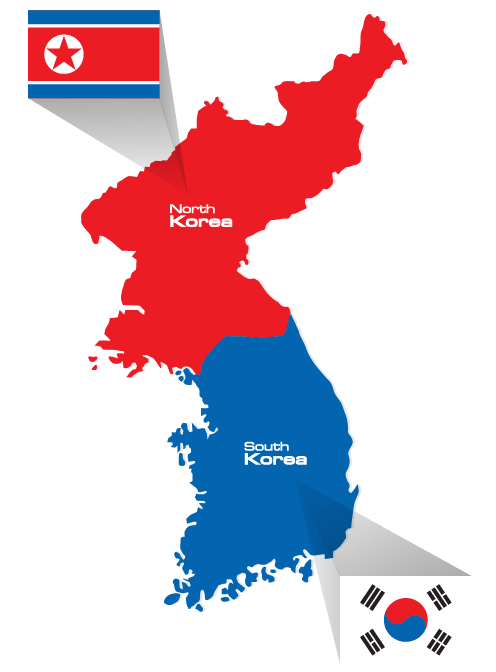Language History
Korean has an ambiguous and mysterious history, making it one of the most interesting languages of today. It is believed to belong to the Altaic language family, which also includes Turkish and Mongolian. “Old Korean” which was spoken before the 15th century is believed to have major influence from Chinese. Chinese characters were used to represent the sounds and meanings of the Korean language at the time. By the 15th century however, a Korean-specific writing system, known today as “Hangul” was made official during the reign of King Sejong.
Interestingly, today, Korean is the official language of both South Korea and North Korea, however, the North has its own dialect and have totally eliminated Chinese characters from their writing system. The South, on the other hand, has various dialects and uses both Chinese and Hangul characters.
[/vc_pangea_service_desc_block][/vc_column][/vc_row][vc_row css=”.vc_custom_1621802492982{background-color: #f1f2f0 !important;}” el_class=”bg-grey”][vc_column css=”.vc_custom_1558445967850{margin-top: -90px !important;margin-bottom: -70px !important;}”][vc_pangea_custom_block layout=”center” button_color=”#d15f45″ content_font=”Open Sans” button_popup_form=”” button_text=”Get in Touch” button_link=”url:https%3A%2F%2Fportal.stg-wpml.pangea.global%2Frequest-quote%2F|||”]According to StudyCountry, roughly 80 million people speak Korean around the world.
[/vc_pangea_custom_block][/vc_column][/vc_row][vc_row css=”.vc_custom_1557920359208{margin-bottom: -50px !important;background-color: #ffffff !important;}”][vc_column css=”.vc_custom_1557920302161{margin-top: -50px !important;margin-bottom: -30px !important;}”][vc_pangea_custom_block layout=”center” heading_font=”Futura Std” content_font=”Open Sans” title=”Where is Korean Spoken?”]Approximately 48 million Korean speakers reside in South Korea, while another 24 million live in North Korea. The language is also spoken in China, by a said 2 million people, as well as 1 million in the United States and about 500,000 in Japan.
The Korean language has six different major dialects in South Korea and one in North Korea.
South Korea Dialects:
• 경기 방언 (Gyeonggi dialect) • 강원 방언 (Gangwon dialect) • 충청 방언 (Chungcheong dialect)
• 경상 방언 (Gyeongsang dialect) • 전라도 방언 (Jeollado dialect) • 제주 방언 (Jeju dialect)
North Korea Dialect: • 평안도 사투리 (Pyongan dialect)
[/vc_pangea_custom_block][/vc_column][/vc_row][vc_row css=”.vc_custom_1643118784624{margin-bottom: 50px !important;background-color: #f1f2f0 !important;}” el_class=”bg-grey”][vc_column width=”1/2″ css=”.vc_custom_1643118973946{margin-top: 20px !important;margin-bottom: 20px !important;margin-left: -10px !important;}”][vc_pangea_custom_block layout=”center” background_color=”” content_font=”Open Sans” css_custom_id=”text-near-bubble” title=”Korean Words with Chinese Influence” background_image=”5847″]• 실내 (shil-nae) – 室内 (shìnèi)
• 연 (yeon) – 烟 (yān)
• 중국 (jung-gug) – 中国 (Zhōngguó)
North Korea Population:
25,727,408
Internet Users:
20,000
Penetration:
0.1%
As of 2019. Source:
www.internetworldstats.com
South Korea Population:
51,339,238
Internet Users:
49,234,329
Penetration:
95.9%
As of 2019. Source:
www.internetworldstats.com
| Korean | English |
|---|---|
| 안녕하세요 – An-nyeong-ha-se-yo | Hello |
| 반갑습니다 – Ban-gap-sum-ni-da | Nice to meet you |
| 감사합니다 – Kam-sa-ham-ni-da | Thank you |
| 밥 먹었어요? – Bap meo-geo-seo-yo? | How are you? |
• Remember! Unlike Japanese and Chinese, Korean is made up of words which are separated by spaces.
• Don’t forget! The relationship between the speaker/writer and subject is reflected in honorifics.
• Bear in mind! When building a sentence in Korean, the Subject-Object-Verb structure is used.
• To change the tense of a word, tenses are attached to the base word. For example, “Sada -> Sayo -> Sa-sseo-yo”.
[/vc_pangea_custom_block][/vc_column][/vc_row][vc_row css=”.vc_custom_1621802526353{background-color: #f1f2f0 !important;}” el_class=”bg-grey”][vc_column css=”.vc_custom_1558438241711{margin-top: -50px !important;}”][vc_pangea_custom_block layout=”center” content_font=”Open Sans”]Are you looking for professional Korean translation services? Get in touch with Pangea Global! We’ll hook you up with one of our professional linguists who will provide you with accurate and reliable Korean localization services, copywriting, voice overs and more![/vc_pangea_custom_block][/vc_column][/vc_row][vc_row css=”.vc_custom_1621802521614{background-color: #f1f2f0 !important;}” el_class=”bg-grey”][vc_column css=”.vc_custom_1557924920503{margin-top: -30px !important;margin-bottom: 40px !important;}”][vc_pangea_cta_button button_text=”Get In Touch” button_link=”url:https%3A%2F%2Fstg-wpml.stg-wpml.pangea.global%2Fquote%2F|||”][/vc_column][/vc_row][vc_row content_placement=”middle” el_id=”no-max-width-container” css=”.vc_custom_1549543529121{margin-bottom: 40px !important;padding-top: -100px !important;background-color: #ffffff !important;}”][vc_column width=”1/2″ css=”.vc_custom_1549535411591{margin-top: 50px !important;}”][/vc_column][vc_column width=”1/2″ css=”.vc_custom_1549535427465{margin-top: 50px !important;border-top-width: -100px !important;}”][/vc_column][/vc_row][vc_row content_placement=”middle” css=”.vc_custom_1558440540407{margin-top: -100px !important;margin-bottom: -50px !important;background-color: #ffffff !important;}”][vc_column css=”.vc_custom_1558440554854{margin-top: -50px !important;margin-bottom: -20px !important;}”][/vc_column][/vc_row]



